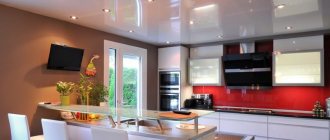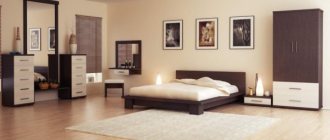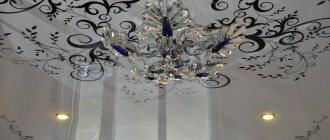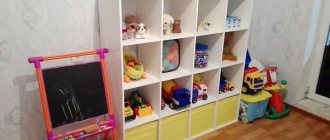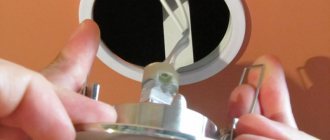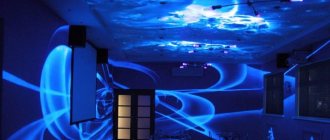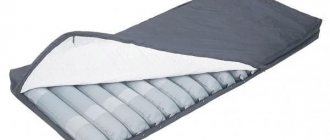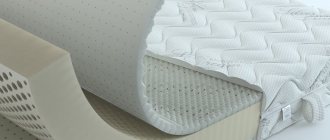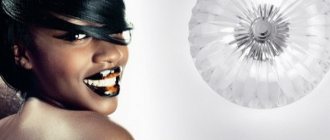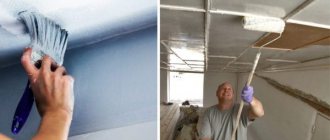Colored
An excellent solution, but only for a flat ceiling. Otherwise, you will have to spend a lot of effort, money and time on pre-painting preparation and leveling.
A clear advantage of this type of repair is the variety of color, light and texture solutions.
Fashionable trends in painting place emphasis on thematic design with frescoes, luminous acrylic and ordinary paints. The result will most likely justify the money and time spent.
Fashionable trends in painting place emphasis on thematic design with frescoes, luminous acrylic and ordinary paints. The result will most likely justify the money and time spent.
The main task when painting is the choice of high-quality, safe, non-toxic materials (solutions, paints).
Drywall
A material that is obtained from natural gypsum laid between two cardboard sheets. For strength and wear resistance, adhesives are added: for example, PVA glue. It is considered quite harmless to health.
There are such ceilings:
- Single-level.
- Multi-level.
Drywall has gained popularity due to its versatility, practicality and affordable price. This material has a number of advantages:
- Environmental friendliness and safety. The material is based on natural raw materials. High-quality drywall that meets standards is non-toxic.
- Low cost.
- Many design variations. Drywall is easy to cut, process and install. Hanging decorative elements can be made from plasterboard.
- Wide selection of colors. Drywall can be painted in any color or combination of colors, or a pattern can be applied to it.
- Easy to care for. True, this quality depends on the quality of the coating.
- Easy to install. Plates of the required size and shape are connected with self-tapping screws and, if necessary, with glue. Does not require highly specialized equipment for installation.
Minuses:
- Construction dust. When sawing and installing, a lot of dust is generated. Requires constant cleaning from dust before each stage of processing (putty, primer, painting).
- Large time costs for the process from installation to the finished ceiling of the design you need. Each layer of putty, primer, and paint requires time to dry. Also, plasterboard coating needs constant dust removal.
- Questionable fire safety. The presence of cardboard makes this material unsafe in rooms where there is a high probability of fire safety violations. Therefore, they came up with a fireproof version impregnated with a special composition. Usually only the gypsum layer is impregnated.
- Unhygienic. In areas with high humidity, it is more likely to grow mold. The market offers plasterboard slabs impregnated with antibacterial substances. However, remember that any chemical impregnation calls into question the safety of using the material in the nursery.
No. 7. Natural wood
Wood, of course, is considered the most natural and environmentally friendly type of finishing , which is especially valued in a children's room. In addition, some types of wood emit bactericidal substances , and any wood has excellent heat and sound insulation properties . This material has never gone out of fashion, it is universal, fits into any interior style, and its appearance is beyond praise.
If you choose wood to decorate a children's ceiling, it is important to meet a number of requirements so that the natural finish does not become a source of danger. For processing and impregnation, you need to select the highest quality and environmentally friendly materials, sanding the wood must be perfect, and care must be constant so that it maintains its appearance and does not become a source of development of insects and bacteria.
Stretch ceiling
Glossy, made of PVC film.
Fabric - made of thermally shrinkable material resembling fabric.
Design ideas
Classic. A white ceiling is the best solution.
Photo printing is a highlight in the nursery interior.
3D effect.
Pros:
- Quick installation.
- Hygiene. If dirty, you can wipe with a damp cloth.
- Non-toxic: if a good certified film is used. The quality and environmental friendliness of such decor depends on the quality of the PVC film.
- Strength and durability.
- Huge variety of color combinations.
- Possibility of photo printing of any complexity.
- Corrects ceiling unevenness, which is difficult to achieve when painting. Creating a flat ceiling using putty will take many times longer than installing a tension version.
Minuses:
- High price. A custom design can cost significantly more than a similar design made from drywall or painted.
- Installed only by professionals with special equipment.
- Partial installation is not possible when a room is zoned.
Wallpapering
Quite a rare occurrence. Such repairs are more acceptable for low rooms and attics.
Today there are more “against” than “for”:
- Inconvenient installation.
- The need for a perfectly flat surface.
- In order for the coating to hold firmly, ideal indoor climate conditions are needed. If you plan to maintain the recommended level of humidity for a child in the nursery, the pasting option is not suitable, since it will be too humid for wallpaper on the ceiling. This can cause mold to form, and the wallpaper may simply peel off.
- Durable adhesives often contain toxic chemicals.
- Purchasing high-quality, environmentally friendly wallpaper and glue will not cost much less than purchasing a plasterboard or stretch ceiling for a child’s room.
How to choose children's wallpaper, read our article.
Plasterboard ceiling for children's room
This finishing material appeared on the domestic construction market about 30 years ago, and at first it was expensive. Now many property owners can afford to create an original ceiling structure from plasterboard sheets.
For the construction of a suspended ceiling in a children's room, gypsum board is best suited. This finishing material consists of two layers of special cardboard, between which there is a gypsum core, which is environmentally friendly and completely safe. The material can be used to decorate the room of a child suffering from allergies.
Drywall has a number of advantages:
- there is no need to prepare the rough ceiling surface before installation;
- good sound and heat insulation properties;
- Fire safety;
- ensuring a comfortable microclimate in the nursery due to the ability to “breathe” that this material has;
- the ability to translate original design ideas into reality.
Drywall also has disadvantages:
- a suspended ceiling in a nursery, especially in several tiers, lowers the height of the room, so it is not installed in rooms with low walls;
- the seams between the sheets have to be hidden so that they are invisible;
- the structure turns out to be heavy and this creates certain difficulties during installation work.
Ceiling in a girl's room
Two-tier soft pink: marshmallow style for a princess.
Wood: harmony with nature.
Elves and fairies: a little fairy tale and magic.
Butterflies: celestial fantasy.
Boy's room
Airplanes: air adventures. 3D stretch ceiling.
Space.
Plasterboard ceiling in a sporty style.
Lighting
The experience of designers and parents shows that the most optimal and competent method of lighting from the point of view of eye health is spot lighting. Such lamps can be easily installed in any suspended ceiling. The layout is planned in advance and the corresponding holes are made.
Today you can choose lighting with remote control, the ability to change brightness and color. Central lighting in the form of a lamp in the middle is suitable if the room is high. You also cannot do without additional lighting of the workplace and a night light.
You can revive and stylize the ceiling in a room using wooden elements, textiles, lamps, and plasterboard compositions.
5 most common mistakes
- You should not ignore the availability of certificates for the materials used in the hope of finding a more budget-friendly finishing option.
- Be sure to ask for certificates not only for the product itself, but also for the installation equipment. This is especially true for glue, paint and moisture-resistant or antibacterial impregnation of drywall.
- Before purchasing, be sure to consider care and cleaning in case of contamination. For a children's room, the issue of cleanliness is one of the most important. When choosing a finishing method, ask yourself the question: how to care for such a ceiling, can it be washed and cleaned if necessary? For example, trendy textiles and embossed decorative elements must be regularly cleaned of dust. The younger the owner of the room, the more often cleaning will be needed.
- You should not choose bright prints for ceiling design. Of course, every parent wants to give their child a fairy tale. But the opinion that bright drawings and images in large quantities develop children's thinking and imagination is wrong. In addition, the atmosphere should be universal for games and sleep. Apply a fabulous, bright design on the walls of the play area. And decorate the ceiling with a universal coloring with a “fairytale” lamp.
- An abundance of angular shapes. Psychologists say that the rounded, streamlined shapes of nursery design elements have a beneficial effect on the child’s psyche. Sharp angles, on the contrary, are associated with tension and aggression. Circles and wavy lines in the design of the ceiling will create comfort and coziness.
False ceiling with triangles.
Round cloud shapes seem to be a cozier design solution.
Think in advance about the location of children's interior items (sports corner, furniture modules, lamps) that are mounted to the ceiling.
Nuances of using tension structures
The popularity of canvases made of vinyl film and fabric impregnated with a polyurethane composition is due to the speed of installation and the wide range of products offered.
Stretch ceilings for a children's room are the optimal solution for apartments with relatively low ceiling heights: the thickness of the materials, not exceeding a few millimeters, allows you to keep the area of the room practically unchanged.
The texture of the fabrics used and their properties vary:
- glossy surface type visually expands the perimeter;
- matte, reminiscent of high-quality plaster, suitable for traditional interior solutions;
- Satin types of materials have a soft shine and are used mainly in sleeping areas.
Among the advantages of tension structures are ease of use (maintenance involves periodic cleaning of dust), hypoallergenicity, and antibacterial properties.
Among the negative characteristics of materials are the high cost of installation (in the absence of skills in working with a heat gun) and low strength. The disadvantages are compensated by the possibility of reconstruction (it should be remembered that only vinyl sheets can be repaired) and the duration of use. A universal version of such a surface - a snow-white satin or glossy product - will create a neutral background for any type of wall and allow you to change the interior if necessary.
Designs with photo printing will help to emphasize the originality of the design of the premises. Complex thematic images - fluttering butterflies, space themes, mountain panoramas, dawn sky - are suitable for a teenager's room. Stretch ceilings with scenes from fairy tales or cartoons - for a nursery where the little ones play and relax. The most original options for arranging ceilings using the specified types of coating are presented in the photo below.
